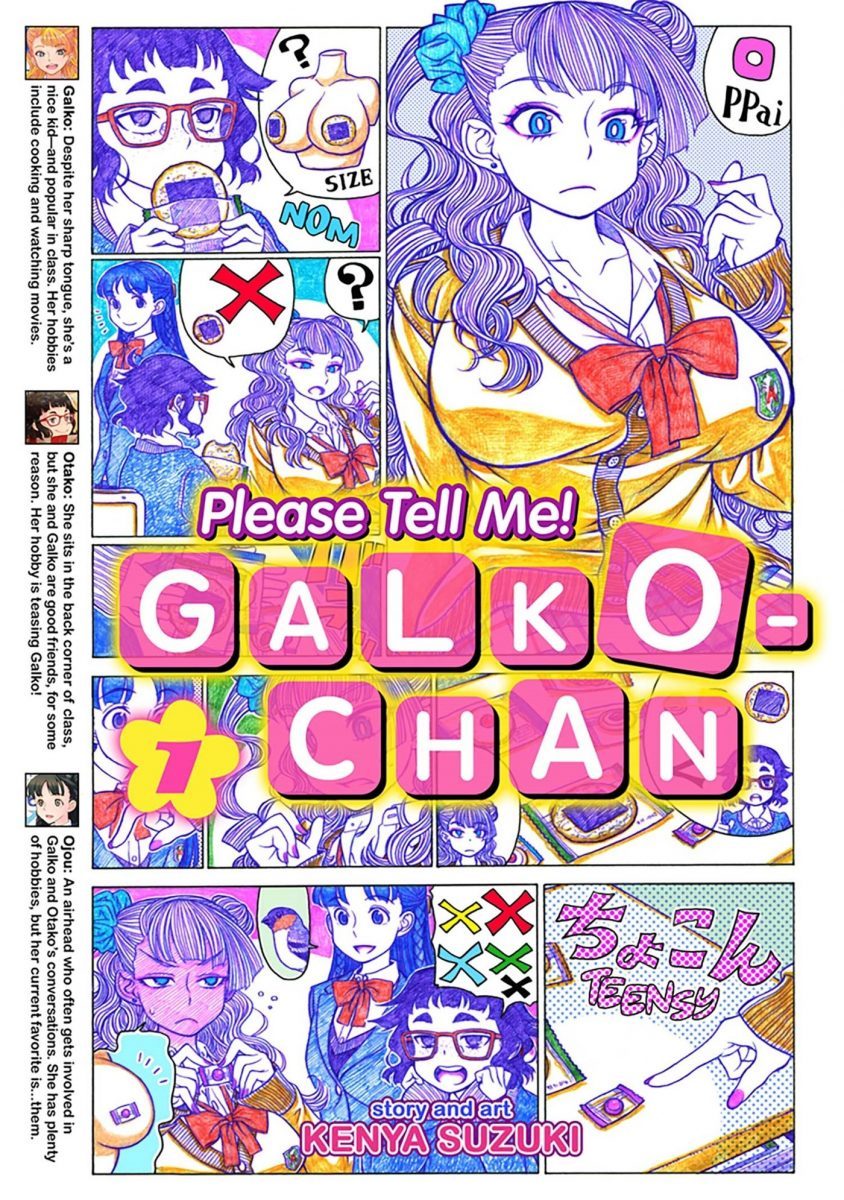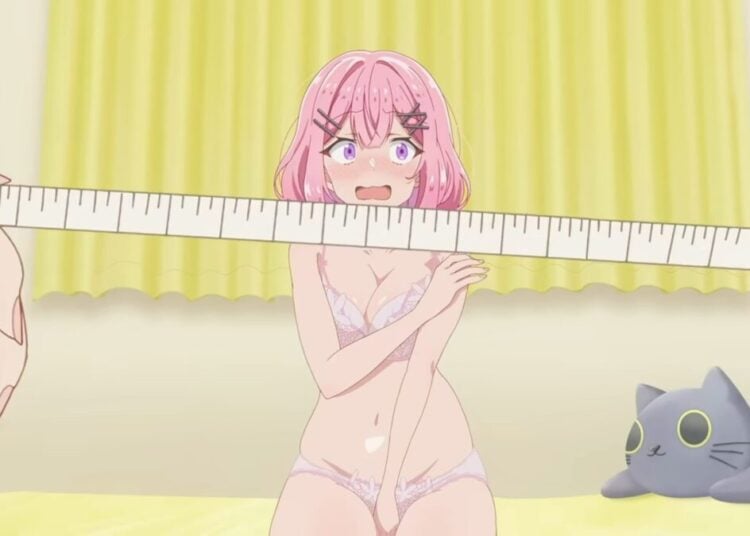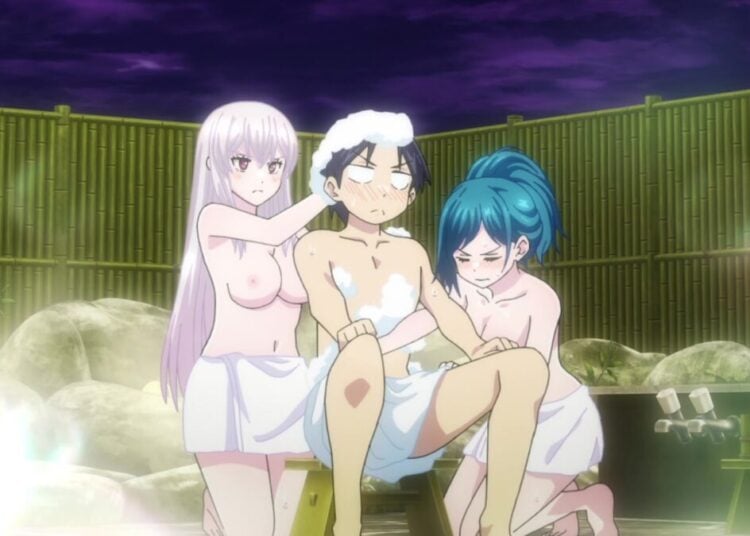Goofy, raunchy, irreverent, sometimes more than a little gross; These were all characteristics I fully expected of the Please Tell Me! Galko-chan manga. After seeing the 2016 anime, I thought I knew what I was in for: a series that reveled in gross-out humor and fan service, yet despite that, somehow had a surprising authenticity and sweetness to it. The manga delivered on the fan service and the bodily functions-centered humor (and does it ever!), but what I did not expect was just how optimistic the world of Galko and her friends is. The irony of Galko-chan — despite leaning on sophomoric humor for its appeal — may be one of the most mature manga I’ve ever read.

The set-up is as basic as it gets. Three high school girls — glamorous Galko, nerdy Otaku, and pampered Ojou — become friends, and talk about all kinds of things together, mainly about sex and growing up. The three girls are intentional stereotypes (Galko belongs to the gyaru subculture), but those stereotypes are used as a jumping off point, not a shortcut for character writing. Along with an extremely colorful cast of secondary characters, they puzzle their way through the mysteries of puberty: no topic too lewd, no body part neglected. However, while the subject matter is risqué, the girls themselves are fairly innocent; Galko-herself is downright bashful when the subject of sex comes up. The charm of the series is in how it portrays the discussion of “naughty” subjects as a universal coming-of-age experience, valuable not because it’s important (or even particularly accurate), but because it’s something adolescents experience together.
To some extent, the appeal of the series is shock humor. Frequently while reading Galko-chan, you might think to yourself “Are they really discussing proper farting technique?” and the answer is yes. Yes, they are discussing nipple hair, and what ancient humans used to wipe their butts with, and so on. But if that were all the manga had to offer, it would get old quickly. What gives Galko-chan staying power, aside from the beautiful artwork, is the fact that we still care about these characters even when they drop the salacious subjects and speak from the heart.
The other quality that makes the manga stand out is its unusually positive view of human nature. Galk0 is an attractive young lady, and just about every male character in the series has a huge crush on her. However, Galko also inspires others with her empathy and kindness. These two things aren’t seen as contradictory in any way: Galko can be sexually attractive, yet also a role model for boys and girls alike. This is the opposite of sexual objectification: Galko is sexy without being a sex object, because no one sees her as an object.
It may seem banal — “You mean, a girl can be sexy and a good person at the same time?!” — but what’s truly unusual about Galk0-chan is not that her character is portrayed this way, but that her multifaceted nature is so widely recognized in-universe. Even the guys who engage in locker-room talk about Galko still obviously respect her, and that respect is shown as natural and intuitive. Some characters in the manga do make the mistake of judging Galko by her looks, but all of them realize their error soon enough, because in Galko-chan most people are inherently good. In the world of Kenya Suzuki’s manga, people want to see other people for who they really are, not what they can credibly accuse them of being. It’s this glass-half-full-view of human nature that allows the manga to sometimes transcend its format as a vehicle for off-color jokes.
You could attempt to summarize the main appeal of the manga by saying that it’s sex-positive, but I wonder if it’s really that simple. Sure, it does tick a lot of the boxes for sex positivity: sexually revealing clothing is not seen as morally deficient in any way, sex being openly discussed and demystified is seen as a good thing, sex workers are portrayed as real people, and so on. However, an important storyline in Volume 5 challenges the idea of Please Tell Me! Galko-chan as a sex-positive manga. Unlike Galko, Galko’s college-aged older sister does more than just talk about sex at school; she has an active sex life, filled with a series of boyfriends and one-night stands. For most of the manga, this seems to be a neutral thing, just a fact of Sis’s life. However, later on, it becomes obvious that Galko’s sister really isn’t happy with her choices, and would vastly prefer to be in a long-term, monogamous relationship with a man she has real feelings for. For people who truly buy into sex positivity, the idea that a sexually active girl is really just looking for the “right” guy to settle down with could be seen as regressive.
Also, note that while Galko, Otako, and Ojou talk about sex a lot, none of them are having sex, and it’s pretty strongly implied that none of them are actually ready for it. In fact, the only school-aged character who expresses real interest in having sex is a middle-schooler, and it’s obvious that she’s rushing things out of insecurity. In the world of this manga, sex is an important milestone and shouldn’t be rushed; that doesn’t necessarily gel with some of the more modern ideas about sex being more casual and/or recreational. Granted, whether or not Please Tell Me! Galko-chan is sex-positive probably isn’t a question that’s keeping anyone up at night (except possibly me).
The other big draw here is the art, which I love. Suzuki draws full-figured women very well (and does it from many interesting angles), so if you’re into that kind of art, buying this series should be a no-brainer. However, the art has a lot going for it besides sex appeal. It’s partially colored, in a very careful and meticulous way that doesn’t take away from the beauty of the line art. Often, after years of manga reading, full-color comics look busy and garish to me. Here, Suzuki somehow uses just enough color to brighten the world of the manga without overwhelming the detailed line art. I’d love to see more manga utilize color in this way because it’s like you’re getting the best of both worlds: the elegance of black-and-white line art, and the warmth and vitality of color. This perfect combination, right up there with peanut butter-and-chocolate, is so lovely that I’d probably want to own all the volumes of this manga even if I didn’t like the story anywhere near as much as I do.
My only real complaint is more of a comment on the differences in translating between English and Japanese. Almost every page of this manga has a little sidebar that introduces the characters (usually the main trio, but sometimes other characters), and you can’t read it without turning the book to the side. This is at worst a minor annoyance, but it does mess with the flow of your reading. I imagine this probably worked a lot better in Japanese with horizontal writing. Still, I’m not sure what else they could have really done; adding the sidebar to the bottom would have required resizing the artwork (no!) and leaving the character intros out would deprive us of some of the series most subtle humor (double no!).
I feel like I’m going out on a limb here, being so positive about Please Tell Me! Galko-chan knowing the impression it makes. The covers usually feature Galko’s boobs and/or butt displayed prominently; the back cover of volume 2 even has a little arrow pointing to Galko’s chest that helpfully says “Boobs,” in case anyone was confused. If you didn’t know any better, you would think it was a title that sold simply on sex appeal. And there’s nothing wrong with a product selling on that basis, but in this case, I wonder if it isn’t doing Suzuki’s work a disservice.
Because even if the sexy aspects of it don’t really do much for you (as is the case for me) there’s still so much here to enjoy and even admire. It’s admirable that Suzuki’s art is so detailed, so nuanced; it’s admirable that he relies on sex appeal as the icing on the cake, while having no lack of cake, err, substance. It’s admirable that he presents such a refreshing, positive view of the dynamics between the sexes. and more important than being admirable, it’s joyful. I’m just overjoyed that this manga exists, and I want more of it.














